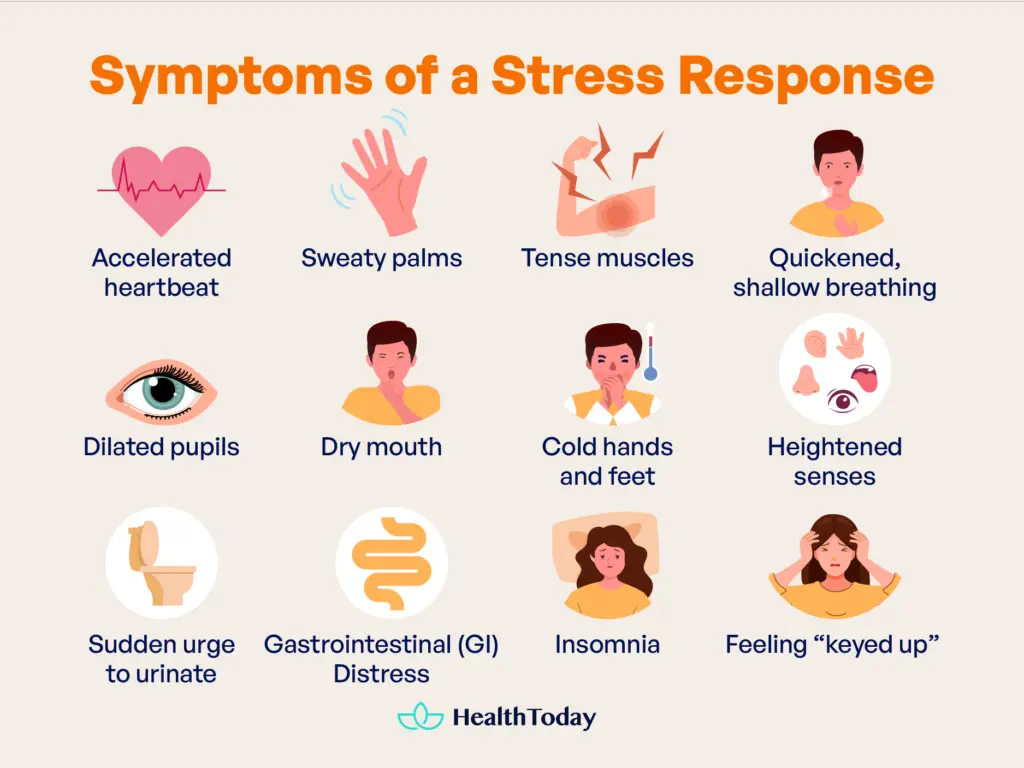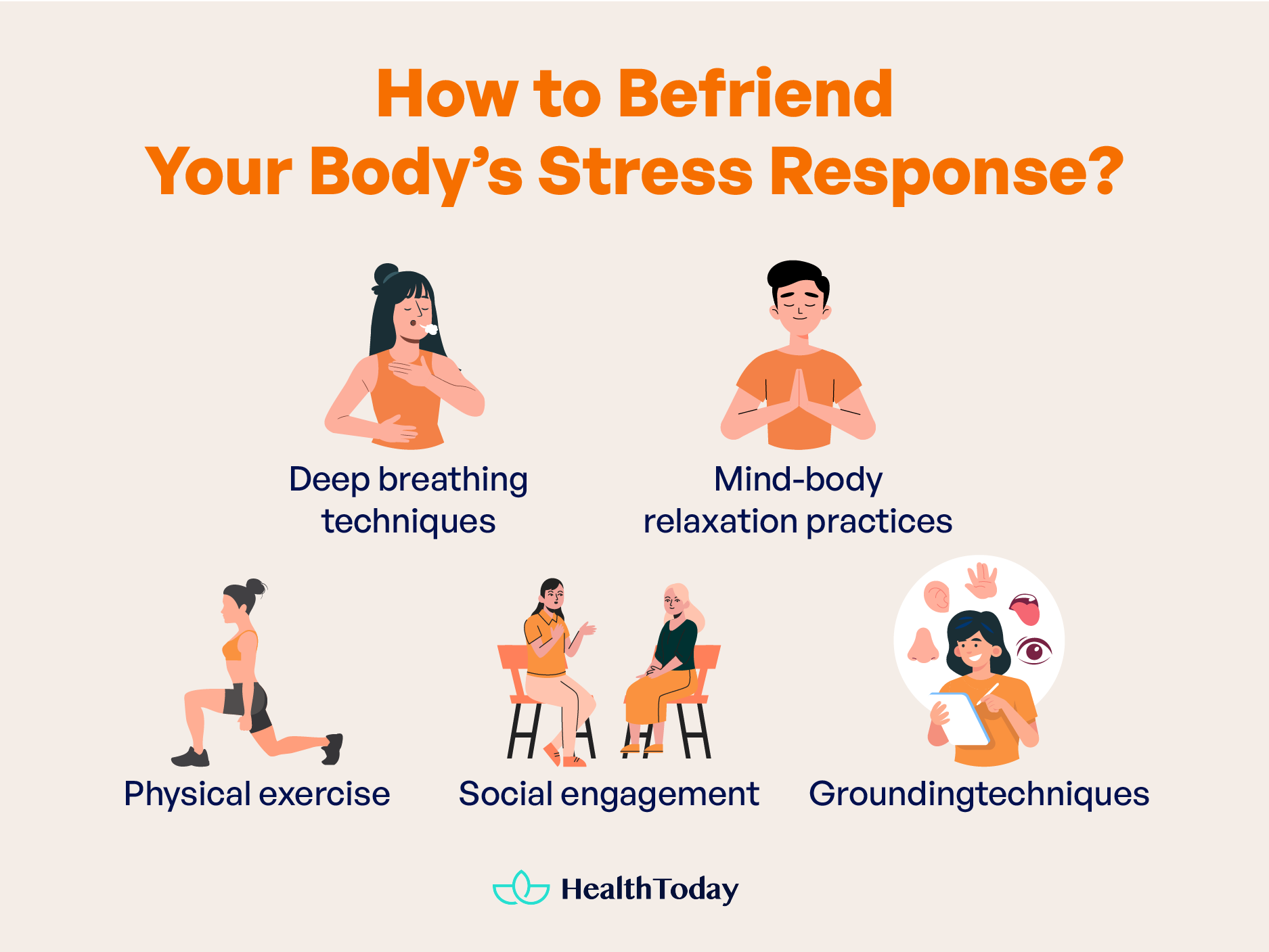Table of Contents
When your heart is pounding, your limbs feel like sprinting, and your palms are sweaty, it’s not just nerves—your fight or flight response (or stress response) is in overdrive. In our overdrive world, where deadlines loom larger than predators, mastering how to calm fight or flight anxiety is key. It isn’t just about soothing jitters; it’s learning to befriend and suppress the stress response when the threat is a ping on your phone, not a prowling beast.
Keep reading to find your guide on how to suppress fight or flight response and take control when your internal alarm bells ring.
What is a stress response?
Picture this: you’re standing at the edge of a vast savannah, your eyes scanning the horizon for predators. Your body is a coiled spring, ready to leap into action and survive (1). Fast forward to modern times, and the “predators” have become unending notifications, looming deadlines, and the constant juggle between work and personal life.
Biologically, our bodies haven’t caught up with the rapid pace of our digital and ever-demanding world. Our adrenal glands react to stress by releasing adrenaline and cortisol, as they did for early humans facing real dangers (1). Yet, our brains often respond to today’s stressors—though less threatening—as if they were ancient hazards, triggering these age-old, evolved chemical responses. While designed to keep us safe, when our stress response becomes chronic, it can offset the balance in many of the body’s systems.
Symptoms of a stress response

When your body enters the stress response stage, you might notice some uncomfortable symptoms. Here are some signs that your body’s emergency broadcast system is shouting out loud, trying to communicate with you:
- Accelerated heartbeat
- Sweaty palms
- Tense muscles
- Quickened, shallow breathing
- Dilated pupils
- Dry mouth
- Cold hands and feet
- Heightened senses
- Sudden urge to urinate
- Gastrointestinal (GI) Distress
- Insomnia, Problems with Sleep
- Feeling “keyed up”
Overactive stress response (fight or flight response)
Although the stress response is a normal bodily function designed to help us gear up and face potential challenges, an overactive stress response is like your body’s security system stuck on red alert.
Let’s back up and have a quick overview of the Autonomic Nervous System to learn more about the stress response. The Autonomic Nervous System is composed of two branches, The Sympathetic Nervous System (SNS), which is your body’s stress response, and The Parasympathetic Nervous System (PNS), which helps to put a pause or break on stress response (2).
The different types of stress responses include fight, flight, freeze, and fawn. The fight or flight response evolved to fight off or flee from a predator. While the freeze response has evolved to protect itself, such as playing dead in the face of a threat. This may manifest as feeling nearly paralyzed or “stuck” when experiencing the stress response.
The fawn response has also been recently acknowledged in the psychotherapy field. This type of stress response may show up as being overly concerned with the needs of others before those of our own. It often develops due to having more of a caretaker role in childhood. For instance, if your parent was overwhelmed with their distress and panic, and you had to take care of them while you were growing up before addressing your own emotional needs. This can lead to feeling overly inclined to put others’ needs before your own, especially in the face of stress.
Regardless of how the stress response manifests for you, this hyper-vigilance can turn life into an endless obstacle course, where every stressor, no matter how small, feels like a giant leap over a pit of snakes.
Why do some people’s systems go into overdrive like this? Genetics and the environmental factors play a role. Traumatic experiences, especially in early life, can tweak your stress response so that it’s always on edge. Constant exposure to stress without adequate recovery time can also recalibrate your nervous system to a state of high alert.
According to a 2005 study, people with an overactive stress response may experience it due to factors ranging from genetics to psychological stress to physical health issues (3).
It’s important to point out that chronic stress can lead to a laundry list of issues, including heart disease, increased inflammation, depression, and a weakened immune system (4).
Seeking therapy can be helpful for those with an overactive stress response. A therapist can help you fine-tune your system, providing you with techniques to dial back the alarm and get curious as to why it may be overly heightened and sensitive in the first place. They can offer cognitive-behavioral strategies that help you reframe your reactions and manage your stress in a healthier way. Utilizing Mindfulness-Based Stress Reduction (MBSB) can be helpful, as well as biofeedback, in further exploring your body’s stress response in real time with a trained practitioner. Biofeedback provides an overview of the nervous system in real-time, providing a more objective measure of physiological stress.
Biofeedback paired with interventions for addressing an overactivated nervous system can be utilized to see how well you respond to the intervention, such as deep breathing or meditation. Addressing underlying factors of nervous system dysregulation may also be helpful with a functional and integrative practitioner.
For instance, compromised digestion, microbiome health, and nutritional deficiencies can manifest in increased anxiety and contribute to an already heightened nervous system. Moreover, adverse childhood experiences, misattunement with our caregivers, and trauma, as emphasized, all impact nervous system health. As noted, genetic predispositions and environmental factors can make us more susceptible or prone to being more frequently caught up in the stress response.
Awareness, mindfulness, inquiry, and integration are all supportive processes in addressing a heightened stress response. Finally, Eye Movement Desensitization and Reprocessing (EMDR) may be a promising therapeutic approach for trauma and Posttraumatic Stress Disorder (PTSD) (5).
How to befriend your body’s stress response?
So, you’ve got your stress response acting like a hyperactive guard dog, barking at every little thing. How do you teach it to chill? Let’s dive into some surprisingly simple yet effective strategies to put your internal security guard on a much-needed break.

Deep breathing techniques
Why does deep breathing feel like a magic trick for stress? Here’s the secret: when you breathe deeply, it sends a signal to your brain to calm down and relax. The brain then forwards this memo to your body. Thus, your heart rate slows, and the panic in your body winds down (6).
Try the 4-7-8 technique. Breathe quietly through the nose for 4 seconds, hold the breath for 7 seconds, and whoosh it out through the mouth for 8 seconds. It’s like a reset button for your nervous system. What’s noteworthy about this breathing technique is that the longer exhale supports the body’s Parasympathetic Nervous System activation. Sighing, interestingly, also promotes the PNS mode.
Mind-body relaxation practices
Imagine telling your body, “Hey, let’s take a mini-vacation.” That’s what mind-body relaxation techniques are all about.
Mindfulness is the ability to take a pause and be with our internal experience with awareness and gentleness. This way, we can reground and support our body’s overactive stress response.
Getting into your body. Sometimes it is hard to talk yourself out of the stress response in the moment. Try not to judge the content of your thoughts, and turn your attention, if you can, to tune in and get into your body.
Progressive muscle relaxation (PMR), for instance, is like giving your body a series of mini-retreats. You tense each muscle group and then release, telling your body it’s okay to relax.
How do you do PMR?
First, find a quiet spot.
Then, start at your feet, work your way up to your calves, thighs, and glutes, and continue to move up your body, all the way to your forehead. Tense each muscle for five seconds, then release for 30 seconds, and relish the sensation of release.
Research suggests that PMR not only reduces stress but can also decrease anxiety and improve sleep (7, 8). That’s like a three-for-one deal. Sleep, as indicated, is vital for modulating nervous system health and anxiety.
Visualization, on the other hand, is like a virtual reality headset for your brain. You imagine a peaceful scene, and your brain goes, “Cool, we’re safe!” reducing the stress response.
To practice visualization, close your eyes, take a deep breath, and imagine your happy place. It could be a cabin in the woods, a quiet library nook, or a beach. Use all your senses to make it real. The smell of saltwater, the sound of waves, the warmth of the sun on your skin. Perhaps, it is helpful to imagine waves coming and going as tiny stressors. The interesting thing about stress is that it is our perception of stress that makes it so real and scary. This is empowering, as we have more power than we think in modulating our nervous system.
Physical exercise
Physical exercise is your body’s way of using energy produced during the fight or flight response.
When you exercise, your body releases endorphins, natural mood lifters (9). A study in The Lancet Psychiatry found that people who exercised had 1.5 fewer days of poor mental health a month than those who didn’t (10).
Aerobic activities like running, swimming, or even brisk walking have been shown to decrease overall tension levels, elevate and stabilize mood, and improve sleep and self-esteem. According to the Anxiety and Depression Association of America, even five minutes of aerobic exercise can stimulate anti-anxiety effects (11).
But maybe you’re not about that sweat life. Perhaps, you’re more a warrior pose than a road warrior. Good news: yoga’s got your back.
Yoga combines physical postures, breathing exercises, and meditation to boost physical and mental well-being. Multiple studies show mindful exercises, such as yoga, are associated with reduced stress and improved mental health (12, 13).
Yoga has also been shown to improve vagal tone, which can have modulating and calming effects on the nervous system. If we have been caught up in our body’s stress response the majority of the time, there is also a good chance that stress, to some extent, resides in parts of our body. There is research to support this in terms of imbalances in body systems, further highlighting the importance of implementing mind-body practices for improving nervous system health.
But what about when you’re in the office, and the closest thing to a workout is running out of patience? Stretching, desk squats, and even seated leg lifts can help keep the stress at bay. This improves blood flow and may lessen tension felt in various parts of the body. For instance, stress often manifests in tension in the shoulders and upper back.
Social engagement
When we engage socially, our body releases oxytocin, a natural stress reliever. A good chat with a friend can soothe your frazzled nerves. Social support is not just about feeling good – it’s a crucial component in managing stress. According to studies, social support significantly reduces cortisol levels, thereby dampening the fight or flight response (14).
This is also in support of The Polyvagal Theory, a scientific theory coined by Steven Porges, PhD, providing novel insights into how the branches of our nervous system function and become activated (15).
Grounding techniques
Grounding techniques are like anchors in the stormy sea of stress. They bring you back to the here and now, which is particularly useful when your mind is time-traveling to the land of “What Ifs” and “Oh Nos.”
Imagine this: you’re in a meeting, and suddenly, you’re hit with a wave of anxiety so strong it could surf. What do you do? You ground yourself. We’re talking about simple, stealthy exercises that can anchor you immediately.
Here’s a quick guide to throwing an anchor down with the 5-4-3-2-1 technique when your anxiety is setting sail:
- Spot 5 things you can see. The stained coffee cup, the over-watered plant, a photo on the wall—anything.
- Touch 4 things you can feel. The cool surface of your desk, the fabric of your pants, the reassuring solidity of your chair.
- Listen for 3 sounds you can hear. The distant chatter, the hum of the AC, the rhythmic tap of your foot.
- Identify 2 things you can smell. If you can’t smell anything, recall your two favorite scents.
- Name 1 thing you can taste. The lingering flavor of your morning toothpaste or the aftertaste of your breakfast.
How to regularly support your nervous system or stress response
The five strategies above offer immediate relief from anxiety, serving as your go-to tools to calm fight or flight response on the spot. But the true strength lies in daily rituals that fortify your mental resilience. Let’s see three preventative practices to help you maintain your inner calm.
Diet and nutrition
What we put in our bodies can be fuel for stress or balm for the nervous system.
High glycemic foods and heavily processed foods can wreak havoc on the nervous system and our mood. These types of foods can cause fluctuations in energy and mood, as well as disrupt the gut microbiome, and compromise digestion, resulting in systemic inflammation over time.
What about caffeine? Sure, it perks you up in the morning, but too much can have you feeling jittery and can amplify anxiety (16). Processed foods and refined carbohydrates can also compromise the quality and diversity of the microbiome. There is a growing body of research in support of the microbiome as being integral to our well-being, as well as anxiety (17). Chronic stress can wreak havoc in the system and contribute to levels of inflammation.
Conversely, foods rich in omega-3 fatty acids, like salmon and walnuts, can have a soothing effect on modulating and reducing inflammation. This is important as systemic inflammation and even low-grade inflammation can impact our brain health and mood.
According to a study, omega-3s may reduce the symptoms of anxiety by up to 20% (18). What’s more is that these healthy fats support the myelin sheath of the nervous system, supporting the stress response.
Furthermore, leafy greens, such as spinach and kale, their chlorophyll-packed companions are rich in magnesium, essential for maintaining balance in the nervous system. Low magnesium levels have been linked with heightened stress and anxiety (19). Rich sources of vitamin C, such as bell peppers, oranges, and strawberries, can also have calming effects on the adrenal glands.
Last but not least, don’t forget water. Mild dehydration can disrupt your performance and heighten cortisol levels, your body’s stress hormone, setting a discordant tone for your day (20, 21). This makes sense as our body is comprised of 75% of water; thus, our physiology depends on it.
Regular quality sleep
Sleep is paramount for the functioning of our body and mind. Quality, restorative, and deep sleep is necessary for the brain and body to detoxify and renew. Sleep activates the glymphatic system, helping to rid it of harmful toxins and supporting anxiety and stress (22).
Furthermore, quality sleep (7-9 hours) is imperative for digestion and gut microbiome health. This is important to rid the body of toxic waste that can wreak havoc on our stress response, as well as synthesize neurotransmitters and other modulators of nervous system health.
Daily mindfulness practices
Mindfulness is about being present in the now, not fretting over yesterday’s gaffes or tomorrow’s to-dos.
Starting a practice can be as simple as spending five minutes in meditation each morning, focusing on your breath—the in, the out, the rise, the fall. A study pointed out that a daily 13-minute meditation practice can help regulate emotions and stress in people with no experience in meditation (23).
But if sitting still isn’t your favorite, mindful walking may work for you.
Try mindful walking, where with each step, you’re fully tuned into the movement of your body, the sensation of the air against your skin, and the sounds cradling your ears (24).
Mindful journaling, meanwhile, can also be effective. Writing down your thoughts can help you become a wise observer and let the negative emotions and feelings pass. Furthermore, writing down what you are grateful for can change your mindset to focus on the good of your life and improve your well-being (25). Research also highlights that identifying how we are feeling has a soothing effect on the amygdala, therefore supporting the body’s alarm system.
Building resilience
Resilience is your psychological immune system.
Building resilience starts with something as simple and as complex as positive thinking. It’s about rewiring your brain, tuning into a frequency where setbacks are seen as temporary and changeable rather than permanent and pervasive.
Statistics show that resilience can indeed be nurtured. A study found that resilience training can lead to significant improvements in psychological well-being (26).
Setting realistic goals is another keystone in the arch of resilience. When you set a goal, no matter how small, and then achieve it, you’re not just ticking off a checkbox. You’re sending a powerful message to yourself: “I can do this.” It’s like planting flags of victory on the terrain of your daily life, creating a trail of successes that boosts your confidence and shores up your resilience. It may also be helpful to think of your proud accomplishments and the resilience you built in getting there.
Can you get stuck in fight or flight mode?
When your body is constantly bombarded with stressors – real or imagined – it can keep you in a perpetual state of fight or flight. Your internal alarm system is jammed in ‘panic’ mode. This isn’t just an emotional ordeal; it can lead to physical symptoms like increased heart rate, anxiety, and sleep disturbances.
How do you calm an overactive amygdala?
Calming an overactive amygdala is like soothing an over-caffeinated squirrel. First, recognize that it’s been sipping too much espresso (stress). Mindfulness practices can help—it’s like switching the espresso for a soothing herbal tea. Deep breathing exercises can also tell your amygdala to chill out and stop overreacting to every little thing. It is also important to engage in daily lifestyle practices conducive to well-being, such as regular quality sleep, movement, and social engagement.
How do you train your brain to stop fear responses?
Training your brain to stop fear responses takes consistency and patience. Exposure therapy is one way, gradually and repeatedly exposing yourself to the fear in a controlled way, like dipping a toe in the pool before diving in. Cognitive-behavioral therapy (CBT) can also retrain your brain by challenging and changing unhelpful thoughts and behaviors, rewiring your reactions to fear over time. Mindfulness-Based Stress Reduction (MBSR), Biofeedback, and EMDR may be further options for exploring your stress response in thoughtful ways with a trained practitioner.
How long does it take your body to get out of fight-or-flight mode?
Exiting fight, flight, freeze, or fawn mode can take 20 to 30 minutes or up to hours. It depends on how well you can convince your body that the “threat” (which might just be a looming deadline) is over. Engaging in relaxation techniques, like those yoga moves you’ve been meaning to try, can speed the return to normal.
What happens if your body is in fight-flight mode for too long?
If your body stays in stress mode for an extended period, it’s like keeping a car revved up at a red light—eventually, something will overheat or wear out. Chronic stress can lead to a host of unfun things like anxiety, depression, digestive problems, and even heart disease. Essentially, it’s your body’s way of telling you it’s time to take a breather and maybe get some sleep for a change.
Bottom Line
We’ve unraveled the complexities of the fight or flight response, understanding its signs, triggers, and when it’s time to seek professional help. We’ve explored practical, everyday strategies to suppress fight or flight response, like deep breathing, mindfulness, and physical exercises.
Now you also understand how nutrition and sleep can be our allies in this quest and the profound role of social engagement and resilience-building in maintaining our mental fortitude.
By integrating these practices into your life, you’re not just learning to cope with stress; you’re learning to dance gracefully with it, turning what was once a foe into a rhythm of life that you move to with ease and confidence.

















Comments
0